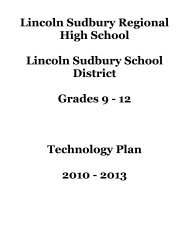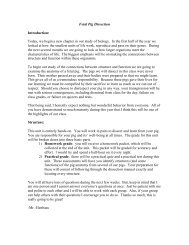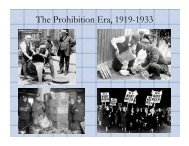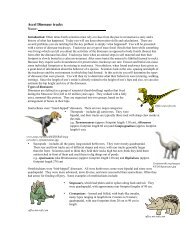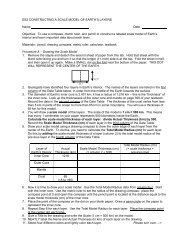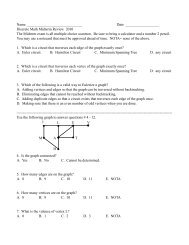Essay Writing Guide
Essay Writing Guide
Essay Writing Guide
You also want an ePaper? Increase the reach of your titles
YUMPU automatically turns print PDFs into web optimized ePapers that Google loves.
Writer’s Toolkit<br />
Persuasive writing will open many doors in your life and is perhaps one of the biggest<br />
challenges you will face as a student. This packet is designed to help you become a<br />
better history writer. Please keep this in your binder throughout the entire school year.<br />
Since this is a toolkit, you might find that some tools are more useful than others. Please<br />
“try on” all the tools before you rule any out.<br />
The ideas represented in this toolkit come from a variety of sources: history teachers<br />
from LS and the Boston Arts Academy, the EMPOWER training manual and Gordon<br />
Harvey, author of <strong>Writing</strong> With Sources.<br />
Habits of Mind for writing<br />
Step 1: Evaluate – What is this assignment asking me to do How many parts will my<br />
paper need to have Circle action words and underline key words that tell you what to<br />
write about.<br />
Step 2: Make a Plan – What kind of organization am I going to use Choices include:<br />
graphic organizers, outlines, lists, diagrams, etc.<br />
Step 3: Organize – Put my plan (graphic organizer, outline, list, or diagram) into action.<br />
Reread the assignment and make sure I’ve answered each part of the question.<br />
Step 4: Work - Write topic sentences and thesis. Follow the MEAL paragraph<br />
format to write your body paragraphs.*<br />
Step 5: Edit – Use the rubric to evaluate your paper. Get feedback from a friend,<br />
teacher or parent.<br />
Step 6: Rework – Make changes to your paper and rewrite if necessary.<br />
This EMPOWER method should help you to write better, more persuasive papers<br />
for history class.<br />
* See the next page for an explanation of the thesis and the MEAL paragraph format.
The Parts of the Analytic Paper<br />
Introductory Paragraph: The opening sentence of the paper should grab the reader’s<br />
attention and set the tone for the paper. The rest of the paragraph should set the<br />
historical context by defining key terms and providing a brief description of the time<br />
period. The introductory paragraph should end with the thesis statement.<br />
Thesis: The thesis statement is the foundation of a persuasive essay. It asserts the<br />
author’s opinion that is supported throughout the body of the paper. Generating a thesis<br />
is hard work. Some might choose to write the thesis statement after writing the body<br />
paragraphs. A strong thesis statement is provable, well thought out, arguable, and<br />
realistic. A thesis considers the proper scope: not too big and not too small.<br />
MEAL plan: Body paragraphs should be written using the MEAL paragraph format.<br />
This format will help you to write and think like a historian. Persuasive writing requires<br />
both ample evidence and convincing analysis. Use the following habits of mind to guide<br />
your body paragraph writing.<br />
Main Idea: What is the main idea of this paragraph This main idea should be clearly<br />
articulated in the topic sentence. Each main idea should support the paper’s thesis.<br />
Evidence: What are the specific examples, quotations, and details that support your<br />
main idea<br />
Analysis: The analysis asks how your evidence supports your thesis and your main<br />
idea. The analysis answers the question: “So what” Analysis clearly explains the<br />
significance of your evidence.<br />
Link: Wrap up the paragraph and either make a “Link” back to the thesis statement or<br />
to the main idea statement.<br />
The Conclusion: The conclusion should revisit the thesis and wrap up the paper’s<br />
argument. A strong conclusion includes a connection to larger issues or themes and<br />
makes clear the significance of the analysis.<br />
Requirements for an analytic paper:<br />
1. Write using 3 rd person. Avoid using: I, me, us, you, we.<br />
2. Final drafts should be typed, using Times New Roman, 12-point font and printed using<br />
black ink.<br />
3. Final drafts should be double-spaced.<br />
4. Quotations should be used and also should be properly cited and formatted.<br />
5. Avoid using the following words: things, really.
6. Papers should be proofread and spellchecked and the rubric should be consulted.<br />
7. Papers should be handed in on time. Please print your papers out before you get to class.<br />
8. Do not use contractions.
How to Cite in an Analytic <strong>Essay</strong><br />
Citing in an analytic essay is crucial for the following reasons:<br />
1. Verifies the evidence<br />
2. Allows an interested reader to find further information<br />
3. Demonstrates understanding of a variety of sources<br />
4. Gives proper credit where credit is due and prevents plagiarism<br />
Gordon Harvey’s Rules for Quoting: These are excellent habits of mind.<br />
1. Quote only what you need.<br />
2. Quote only what is striking.<br />
3. Don’t let other authors do the thinking for you.<br />
4. Before and after quoting someone else, add your own analysis.<br />
5. Construct your own sentence so that the quotation fits smoothly into it.<br />
6. Indent and single-space all quotations that are longer than 3 lines.<br />
7. Always make clear how each source introduced into the paper relates to the<br />
argument.<br />
Examples of Linking words<br />
These words are synonyms for “AND” and join two equal ideas.<br />
Furthermore<br />
Moreover<br />
In addition<br />
Likewise<br />
Besides<br />
For example<br />
once more<br />
also<br />
in the next place<br />
again<br />
similarly<br />
for instance<br />
The following words are synonyms for “BUT” and show a contradiction or<br />
exception<br />
Then<br />
Still<br />
However<br />
Yet<br />
although<br />
on the contrary<br />
nevertheless<br />
in spite of that<br />
on the other hand
The following words imply cause/effect.<br />
Therefore<br />
Consequently<br />
Thus<br />
Accordingly<br />
As might be expected<br />
as a result<br />
in consequence<br />
so<br />
subsequently<br />
since<br />
Words used to express the passing of time.<br />
Later<br />
Soon<br />
Before long<br />
Until<br />
After<br />
As<br />
Next<br />
meanwhile<br />
shortly thereafter<br />
sometimes<br />
since<br />
whenever<br />
while<br />
finally
Analytic <strong>Essay</strong> Outline Example<br />
Introduction Paragraph: What info needs to be provided to set the historic context<br />
________________________________________________________________________<br />
________________________________________________________________________<br />
________________________________________________________________________<br />
________________________________________________________________________<br />
Thesis: _________________________________________________________________<br />
________________________________________________________________________<br />
Body Paragraph:<br />
Main Idea: ______________________________________________________________<br />
________________________________________________________________________<br />
Examples: ______________________________________________________________<br />
________________________________________________________________________<br />
________________________________________________________________________<br />
________________________________________________________________________<br />
Analysis: _______________________________________________________________<br />
________________________________________________________________________<br />
________________________________________________________________________<br />
________________________________________________________________________<br />
Link: ___________________________________________________________________<br />
________________________________________________________________________<br />
Body Paragraph:<br />
Main Idea: ______________________________________________________________<br />
________________________________________________________________________<br />
Examples: ______________________________________________________________<br />
________________________________________________________________________<br />
________________________________________________________________________<br />
________________________________________________________________________<br />
Analysis: _______________________________________________________________
________________________________________________________________________<br />
________________________________________________________________________<br />
________________________________________________________________________<br />
Link: ___________________________________________________________________<br />
Body Paragraph:<br />
Main Idea: ______________________________________________________________<br />
________________________________________________________________________<br />
Examples: ______________________________________________________________<br />
________________________________________________________________________<br />
________________________________________________________________________<br />
________________________________________________________________________<br />
Analysis: _______________________________________________________________<br />
________________________________________________________________________<br />
________________________________________________________________________<br />
________________________________________________________________________<br />
Link: ___________________________________________________________________<br />
________________________________________________________________________<br />
Conclusion: What new connections can be made ______________________________<br />
________________________________________________________________________<br />
________________________________________________________________________


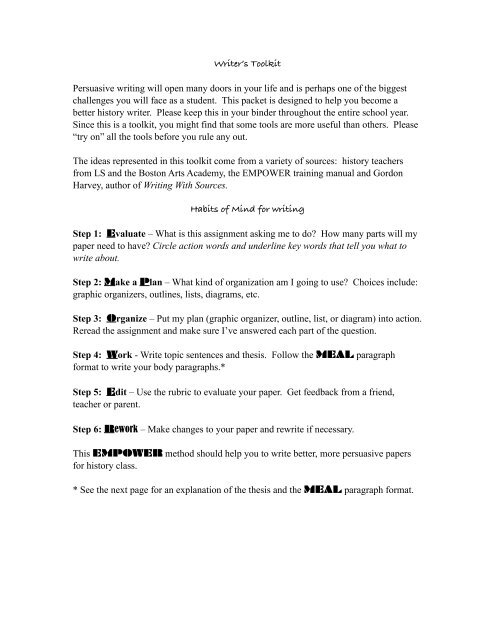
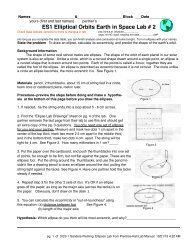


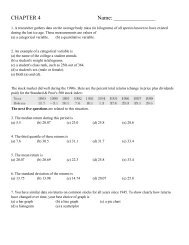
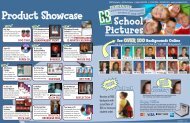

![';1asAu ro; las I sgeo8 leuo!]eslanuol aql utelqo o1 palenttouJ ue I ...](https://img.yumpu.com/49072782/1/190x221/1asau-ro-las-i-sgeo8-leuoeslanuol-aql-utelqo-o1-palenttouj-ue-i-.jpg?quality=85)
